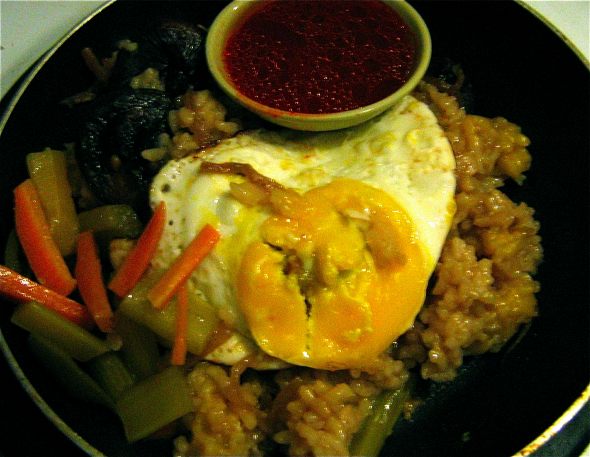The trick to a good bibimbap, as far as I know, is the sauce. You take some sweet rice and cook it until it’s perfect and then some vegetables and meat cut into strips (chicken, beef or pork, preferably marinated, leftover or freshly cooked), but you don’t even need the meat. To get your protein out of this dish all you do is drop a fried egg on top. The sauce and stone pot (I don’t have one of those either. Don’t worry) will take care of the rest.
Vegetable, carbohydrate, protein…and hot sauce (aka a well-balanced meal)
So I had to get the sauce right. The spicy red pepper sauce, Gochujang, is made from fermented chilies. There’s a long, arduous, sun-drying process involved that is not practical in a Montreal winter. Fortunately, I had some fermented chili paste left over from the summer. This is obviously NOT gochujang, but it was going to have to be good enough. If you buy from a store, or want to learn more about gochujang, check out One Fork, One Spoon for a taste test.
I didn’t want to put my fake gochujang on top of my bibimbap as it was, however, because it needed to be rounded out first. Gochujang has a lot of body to the flavour from the fermented soy beans. If I’d had any natto left over (I don’t think I wrote about that experiment, but I took the last 1/2 cup of natto – fermented soybeans – from a container I bought at the Japanese Canadian Cultural Centre Bazaar and used it as a starter for some soaked and cooked adzuki beans. The adzuki beans fermented well, and I ended up with almost two litres of the sticky, smelly, delicious stuff) I may have considered throwing that in, which is, again, very wrong but may have worked better than what I did do instead:
2 tablespoon rice wine vinegar
4 teaspoons sesame oil
4 tablespoons gochujang
2 tablespoon sugar
WAY too much rice wine vinegar the first time I made the dish. Not enough sugar. I forgot that my fermented chilies already had some vinegar in them. And the marinated veggies I served on the rice also had vinegar. So all in all there were just way too many pickled things in the less-than-stone bowl.
If you use store-bought or home-made actual Gochujang, this recipe above may work. Be careful with your vegetables, though.
Bibimbap:
2-3 carrots
1 long cucumber
other vegetables (re-hydrated seaweed, zucchini, daikon radish, celery, dried radish threads, re-hydrated mushrooms)
1/2 cup vinegar
1 tsp salt
1/4 cup sugar
1/4 cup water
2 cups cooked sweet rice
1 egg per person (about 2 eggs for the amount of rice)
Gochujang sauce (above)
Directions: Make the rice first, so it’s ready when you need it. All the liquid needs to absorb so it crackles on the “stone” frying pan or bowl.
I had some pickled carrots and jalapenos in the fridge, so my vegetable process was easy: I drained the brine into a saucepan, brought it to a boil, and added the cucumbers to soften them for about 30-45 seconds. Then I poured the whole thing back over the jalapenos and carrots.
What you can do if you don’t have a bunch of pickled vegetables kicking around is steam the vegetables in the vinegar, salt, sugar, and water above, or blanch them separately and then pour the vinegar, salt, and sugar mixture over top. Let them sit in the brine until you’re ready to eat.
Then put together the bibimbap sauce with your proper gochujang.
You need to eat this right away and right out of the frying pan, so if you’re serving more than one person, you’ll need more than one frying pan.
Fry an egg (in each pan) on one side only with a little sesame oil. Then in an effort to pretend that you have a stone pot, move the still giggly egg onto a plate while you add a cup of rice to the frying pan. Let it brown and char a little on the bottom. Top with some of the marinated vegetables (removed from the brine so that the wetness doesn’t undo all your crisped rice work), and put the egg back on top. Pour the sauce over top, and place frying pan in front of diner (or yourself. Eating at the stove is acceptable in this case in my books). Break the egg and let it coat everything in creamy goodness and cook into the rice because of the heat coming off the frying pan. If you’re paranoid about un-cooked eggs, let it scramble on the stove a little before moving it to the table, but it’s better when it’s soft and creamy. I also grilled some un-traditional sardines and threw them on top at the end because everything is delicious in home-made hot sauce. You need not do this.
Marvel at the wonders of Korean food.
Next stop: the Asian food stores in search of good Gochujang. I’m fresh out of ALL my summer hot sauces made from local peppers. I made 4 and I ate them all. If you know any Korean mothers making their own Gochujang without MSG, please let me know.

I really like your writing style, and I’m hoping for more posts like this one.